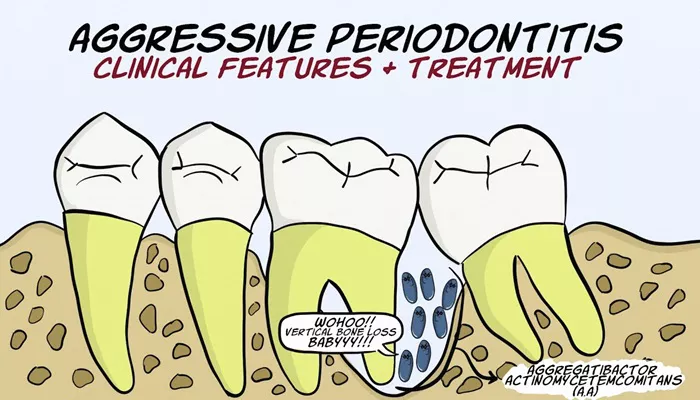Aggressive periodontitis is a severe form of gum disease characterized by rapid destruction of the supporting structures of teeth, including the gums and bone. Unlike chronic periodontitis, aggressive periodontitis progresses quickly and often affects younger individuals. Early diagnosis and treatment are crucial to prevent tooth loss and maintain oral health.
This condition is marked by intense gum inflammation, deep pockets around teeth, and bone loss. It may also be associated with systemic factors such as immune system problems. Understanding aggressive periodontitis and its treatment options can help patients protect their smiles.
Causes and Risk Factors
Bacterial Infection
Aggressive periodontitis is mainly caused by specific bacteria that attack the gums and bone. These bacteria trigger severe gum inflammation, leading to tissue destruction.
Genetic Factors
Some people inherit a tendency to develop aggressive periodontitis. Family history plays a significant role in susceptibility.
Immune System Dysfunction
Problems with the body’s immune response can worsen the destruction caused by bacteria. The immune system fails to control infection effectively, allowing aggressive progression.
Other Factors
Smoking, stress, poor oral hygiene, and systemic diseases can increase the risk or severity of aggressive periodontitis.
Signs and Symptoms of Aggressive Periodontitis
- Severe gum inflammation and redness
- Swollen gums that may bleed easily
- Deep periodontal pockets around teeth
- Rapid loss of bone supporting teeth
- Tooth mobility and shifting
- Persistent bad breath
Early signs can sometimes be confused with gum inflammation or pericoronitis (inflammation around partially erupted wisdom teeth). However, aggressive periodontitis causes faster and more extensive damage.
Diagnosis of Aggressive Periodontitis
Clinical Examination
The dentist examines your gums for swelling, bleeding, pocket depth, and tooth mobility. Measuring periodontal pockets is important to assess severity.
Dental X-rays
X-rays reveal bone loss around teeth, helping confirm the diagnosis and determine disease extent.
Microbial Testing
In some cases, specific bacterial tests may be done to identify harmful bacteria causing the infection.
Treatment Goals for Aggressive Periodontitis
- Stop the progression of the disease
- Reduce bacterial infection and inflammation
- Preserve the teeth and supporting bone
- Restore healthy gum tissue
- Prevent recurrence
Non-Surgical Treatment Options
Scaling and Root Planing
This deep cleaning procedure removes plaque and calculus from below the gum line and smooths the tooth roots. It helps eliminate bacteria and promotes gum reattachment.
Antibiotic Therapy
Due to the aggressive nature of this disease, systemic antibiotics such as doxycycline or amoxicillin may be prescribed. They help control the bacterial infection alongside mechanical cleaning.
Improved Oral Hygiene
Patients must maintain strict oral hygiene at home. Brushing twice daily with fluoride toothpaste and flossing daily reduce bacterial buildup and inflammation.
Managing Gum Inflammation
Anti-inflammatory mouth rinses or gels may be recommended to control gum inflammation and provide relief.
Surgical Treatment Options
Flap Surgery
When pockets are too deep for non-surgical cleaning, flap surgery allows the dentist to lift the gums, clean the roots thoroughly, and reduce pocket depths.
Bone Grafting
If bone loss is severe, bone grafts help regenerate lost bone and provide better support for teeth.
Tissue Regeneration Procedures
Guided tissue regeneration uses special membranes to stimulate regrowth of gum tissue and bone in damaged areas.
Laser Therapy
Laser treatment can remove infected tissue and bacteria with minimal discomfort, promoting faster healing.
Special Considerations in Aggressive Periodontitis
Addressing Pericoronitis
Pericoronitis, inflammation of gum tissue around partially erupted teeth, especially wisdom teeth, can complicate treatment. Managing this condition promptly helps prevent additional infection and inflammation.
Regular Monitoring and Maintenance
After initial treatment, frequent dental visits for professional cleaning and monitoring are vital to prevent relapse.
Patient Education and Motivation
Educating patients about the importance of oral hygiene, diet, and avoiding smoking supports long-term success.
The Role of Cosmetic Dentistry
After controlling aggressive periodontitis, cosmetic dentistry can restore aesthetics by correcting gum recession or uneven gum lines caused by the disease. Procedures like gum grafting and contouring improve appearance and help protect sensitive tooth roots.
Lifestyle Changes to Support Treatment
- Quit smoking to enhance healing and reduce disease severity
- Maintain a nutritious diet rich in vitamins C and D
- Manage stress as it can affect immune response
- Practice good oral hygiene consistently
When to See a Periodontist
If you notice rapid gum inflammation, bleeding, or tooth mobility, seeing a periodontist—a specialist in gum diseases—is essential. They provide advanced care tailored to aggressive periodontitis and help save your teeth.
Conclusion
Treating aggressive periodontitis requires a comprehensive approach including professional deep cleaning, antibiotics, surgery when necessary, and strict oral hygiene. Managing gum inflammation and related conditions like pericoronitis is also critical. Combined with lifestyle changes and regular dental care, these steps can stop the disease’s progression and maintain oral health.

